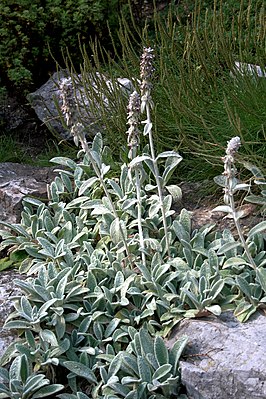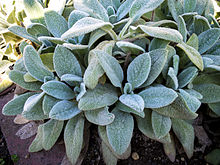Woll-Ziest
| Woll-Ziest | ||||||||||||
|---|---|---|---|---|---|---|---|---|---|---|---|---|

Woolen ziest ( Stachys byzantina ) |
||||||||||||
| Systematics | ||||||||||||
|
||||||||||||
| Scientific name | ||||||||||||
| Stachys byzantina | ||||||||||||
| cook |
The wool Ziest ( Stachys byzantina ), also Wollziest , Woolly Ziest , Bookmark , Hasenohr called, is a plant from the genus Stachys ( Stachys ) within the family of Labiatae (Lamiaceae).
Description and ecology
Vegetative characteristics
The Woll-Ziest grows as a perennial herbaceous plant and reaches heights of about 60 to 80 centimeters. The aboveground parts of the plant are mostly dense gray or white, silky-woolly hairy ( indument ). The stems are square.
The opposite arranged leaves are divided into a petiole and a leaf blade. The very short petiole is almost encompassing the stem, it can be almost entirely absent. The simple leaf blade of the lower stem leaves is elongated-elliptical with a length of about 10 centimeters and a width of about 2.5 centimeters with a narrowed blade base and a pointed upper end. The leaf margin is notched to entire.
Generative characteristics
The annual inflorescence contains multi-flowered pseudo whorls with 15 to 20 flowers each, which, apart from the lowest one to three, are close together. The bracts are almost sessile and tiny, with the lowest slightly longer and the uppermost shorter than the pseudo whorls. The bracts are linear to linear-lanceolate with a length of about 6 millimeters.
In Central Europe the flowering time extends from June to July, depending on the location it can also last until August. The seated, hermaphrodite flowers are zygomorphic and five-fold with a double flower envelope . The five approximately 1.2 centimeters long sepals are fused tubular-bell-shaped. The slightly curved calyx is ten-nerved and bald, only the calyx teeth are hairy on the inside, or closely haired on the outside. The oval-triangular calyx teeth, 2 to 3 millimeters long, are almost the same, or the rear ones are larger, and the tips are stiff. The 1.2 cm long corolla is hairy and woolly, only its base is bare and it is two-lipped. The corolla tube is about 6 millimeters long. The upper lip is egg-shaped with a smooth edge. The lower lip is almost expanded with broad, ovate central lobes and elongated side lobes. There are four stamens , the front pair of which is longer. The stamens are hairy from their base to the middle. The stylus towers over the corolla.
When ripe, the elongated nuts are brown and bare.
The number of chromosomes is 2n = 30.
distribution
Stachys byzantina is native to the Middle East and the Caucasus . There are information about the place of discovery from Armenia , Azerbaijan , northern Iran and northern Turkey , here partly also further south, in western central Anatolia. She is a neophyte elsewhere , for example in the Crimea . In Italy, the species occurs almost only subspontaneously and adventively , especially near cemeteries.
Taxonomy
The valid first description of Stachys byzantina was made in 1849 by Karl Heinrich Koch in Linnaea , Volume 21, p. 686. Synonyms for Stachys byzantina Koch are: Eriostomum lanatum Hoffmanns. & Link , Stachys lanata Jacq. nom. illeg., Stachys olympica Poir. Zefir , Stachys taurica . The specific epithet byzantina refers to the site of Byzantium, the former name of the city of Istanbul .
Stachys byzantina belongs in the genus Stachys in the section Eriostomum , subsection Creticae . Closely related species are common in the eastern Mediterranean and Anatolia; Sister species could be Stachys cretica .
use
Some varieties of the Woll Ziest (for example 'Silver Carpet', 'Cotton Boll', 'Primrose Heron') are used as ornamental plants . The Woll-Ziest is mainly used as a ground cover, for example for Mediterranean gardens, green roofs , in the Alpinum and in the scree garden , between wide tile joints. It can be planted outdoors in USDA climate zones 4–9 and is frost hardy there.
Individual evidence
- ↑ a b c d Stachys byzantina in the Germplasm Resources Information Network (GRIN), USDA , ARS , National Genetic Resources Program. National Germplasm Resources Laboratory, Beltsville, Maryland. Retrieved February 18, 2016.
- ↑ a b c d Peter Kiermeier: Ground cover in portrait , In: Deutsche Baumschule , No. 08/2011: Wolliger Ziest - Stachys byzantina data sheet of the Weihenstephan information service of the Weihenstephan-Triesdorf University of Applied Sciences.
- ↑ a b Gordon Cheers (Ed.): Botanica. The ABC of plants. 10,000 species in text and images . Könemann Verlagsgesellschaft, 2003, ISBN 3-8331-1600-5 (therein page 856).
- ↑ a b c Bernd Hertle, Peter Kiermeier, Marion Nickig: Garden flowers, Das große GU PraxisHandbuch - Das große GU Praxishandbuch . Gräfe & Unzer, 2008, ISBN 978-3-8338-0704-6 , pp. 213 ( Stachys byzantina on p. 213 in the Google book search).
- ↑ a b c d e f Xi-wen Li, Ian C. Hedge: Stachys. : Stachys lanata Jacq. , P. 179 - online with the same text as the printed work In: Wu Zheng-yi, Peter H. Raven (Ed.): Flora of China. Volume 17: Verbenaceae through Solanaceae , Science Press and Missouri Botanical Garden Press, Beijing and St. Louis 1994, ISBN 0-915279-24-X .
- ↑ a b c d Lucia Falciani (1997): Systematic Revision of Stachys sect. Eriostomum (Hoffmanns. & Link) Dumort. in Italy. Lagascalia 19 (1/2): 187-238.
- ↑ a b Datasheet of the Herbaceous Ornamental Plants section of Oregon State University's Landscape Plants website .
- ↑ Stachys byzantina at Tropicos.org. In: IPCN Chromosome Reports . Missouri Botanical Garden, St. Louis
- ↑ a b c d Rafaël Govaerts (Ed.): Stachys byzantina. In: World Checklist of Selected Plant Families (WCSP) - The Board of Trustees of the Royal Botanic Gardens, Kew . Retrieved February 18, 2016.
- ↑ Tunkay Dirmenci, Bayram Yıldız, Ekrem Açiçek, Esra Martin, Ekrem Dündar (2011): Stachys vuralii (Lamiaceae), a new species from north Anatolia, Turkey. Annales Botanici Fennici 48: 401-408.
- ↑ a b data sheet at Euro + Med PlantBase with data from WCSP .
- ↑ Koch scanned in at biodiversitylibrary.org in 1848 .
- ↑ Stachys byzantina at Tropicos.org. Missouri Botanical Garden, St. Louis, accessed February 18, 2016.
- ^ Online Dictionary of Botanical Epithets .
- ↑ Ekrem Dündar, Ekrem Açiçek, Tuncay Dirmenci, Şakir Akgün (2013): Phylogenetic analysis of the genus Stachys sect. Eriostomum (Lamiaceae) in Turkey based on nuclear ribosomal ITS sequences. Turkish Journal of Botany 37: 14-23.
- ↑ Data sheet with photos at missouriplants.com .
- ^ Richard G. Hawke: Plant Evaluation Notes - A Comparative Study of Cultivated Stachys - PDF of the Chicago Botanic Garden.
Web links
further reading
- Y. Salmaki, S. Zarre, Rafaël Govaerts, C. Bräuchler: A taxonomic revision of the genus Stachys (Lamiaceae: Lamioideae) in Iran. In: Botanical Journal of the Linnean Society , Volume 170, 2012, pp. 573-617.
- Mahnaz Khanavi, Abbas Hadjiakhoondi, Gholamreza Amin, Yaghoob Amanzadeh, Abdolhossein Rustaiyan, Ahmad Shafiee: Comparison of the volatile composition of Stachys persica Gmel. and Stachys byzantina C. Koch. oils obtained by hydrodistillation and steam distillation. In: Zeitschrift für Naturforschorschung C. , Volume 59, 7–8, 2004, pp. 463–7. doi : 10.1515 / znc-2004-7-802 online.



